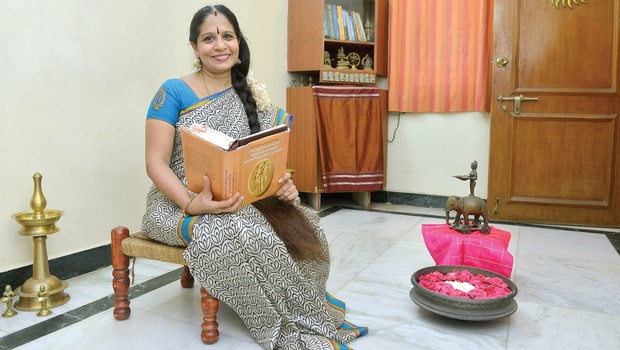
The unknown intrigues her as she skims through texts of a bygone era.
Dr Lakshmi Ramaswamy depicts these stories meticulously through theatre and dance, two art forms she has cherished since childhood. While performing, she effortlessly slips into the persona of a woman from the first century, expressing her feelings for her lover to a friend or that of a land-conquering warrior. Currently, the great Tamil epic—
Silappadikaram—is the subject of her imaginative scrutiny.
For the Chennai-based danseuse and researcher, ancient Tamil texts, especially those belonging to the Sangam Period, are enthralling beyond measure. “There is grace in its classicism and rhythm in its realism. Else, why then would it be called the Golden Age? They are vivid in human emotions and exceptionally particular about ethics. Everything is based on ethics, even raging a war had its own norms then,” she explains.
Way back in 1987 when Lakshmi, now a top-notch Doordarshan artiste, performed her first solo debut at a gathering of 7,000 people in Tirunelveli, Tamil Nadu, dance to her was only a glittery affair. For more than a decade, she remained only a performer, far from the vicinity of the academics of dance.
Lakshmi, who holds a master’s degree in commerce, shifted to Chennai after marriage and enrolled for a master’s degree in Bharatanatyam at the University of Madras. She took up the task of interpreting the Koothanool, a rare Tamil text in which she did her doctorate. “And this was the beginning,” says the first Fulbright Fellow in Bharatanatyam.
Full-length productions based on her research works began with Natrinai, a collection of 400 songs of aham poetry (that which deals with the relationship of a man and a woman) followed by Ainkurunuru, which is still untouched by any other dancer. The response to these performances was encouraging and helped Lakshmi carve an inimitable niche for herself.
Supported by her guide and professor, Dr S Raghuraman, Lakshmi made productions such as Tirumalai Aandaver Kuravanji based on Kuravanji Literature, Purananuru from Sangam Age poetries, and many more. Currently, Lakshmi has received a senior fellowship from the Ministry of Culture to work on the great Tamil epic,
Silappadikaram, authored by Ilango Adigal in the second century.
The story of Kannagi, Kovalan and Madhavi is known to most. But according to the scholar, “there is much more that needs to be fathomed”. She believes the text is an encyclopedia for historians, musicians and dancers. “The text’s myriad layers are challenging and contain jaw-dropping information on both grammar and performance that were in vogue then,” she says. Lakshmi says that though Ilango was a Buddhist, the writer was tolerant towards all religions. “Religion in those days meant each of the landscapes being connected to a presiding deity,” she explains. “For example, Lord Muruga was the deity of the Kurinji or the mountain regions. The text mentions a wide variety of dances, including those done by soldiers and ghosts.”
While Lakshmi is proud of literature of the past, she equally appreciates meaningful contemporary work. However, working on such productions brings with it multiple challenges.
“The phase of interpreting is time-consuming with limited resources; managing funds for sets, costumes and lights is a separate ball game; platforms to showcase such productions are quite few and they too have budget constrictions,” she says. But that does not stop the determined artiste, whose cascading long hair and warm smile only add to her charming personality.
“My mission is to ignite the minds of my students. That is my bhakti towards my work and not merely lighting lamps,” says the teacher whose institution Sri Mudhraalaya is now 21 years old. Besides dance, theatre, history, theory, lighting, stage presentation and choreography are taught at her school.
source: http://www.newindianexpress.com / The New Indian Express / Home> Magazine / by Jagyaseni Chatterjee / October 24th, 2015